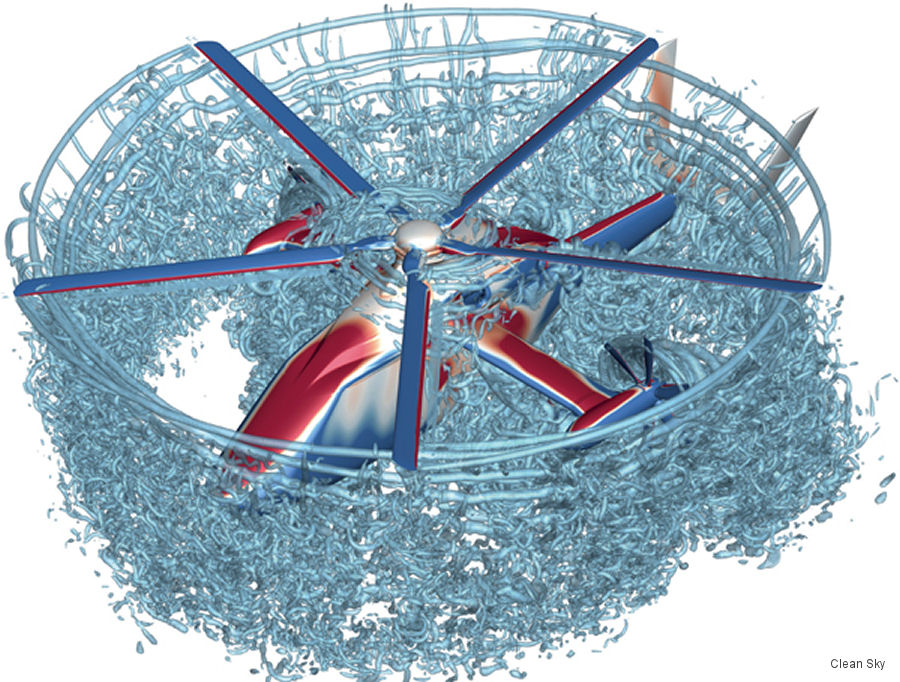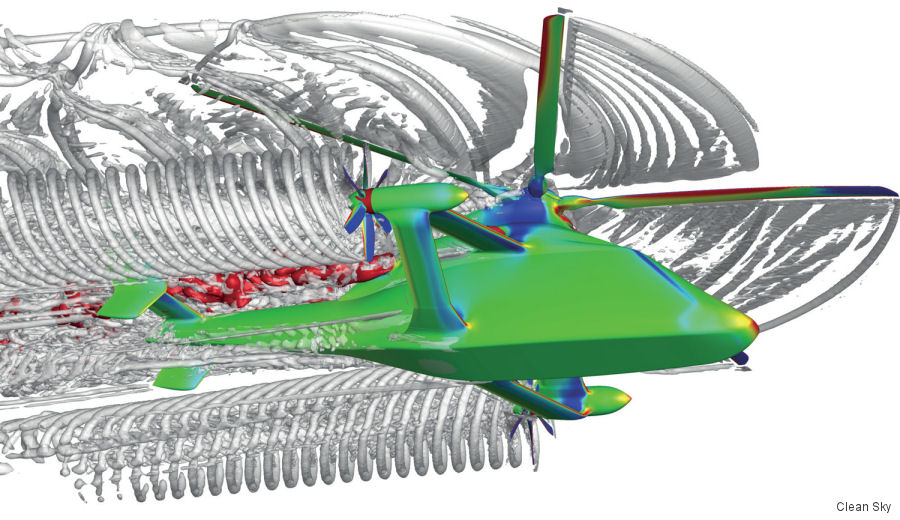
CleanSky, April 03, 2019 - Now into the final year of its 48-month timeline, Clean Sky’s CA³TCH (Comprehensive Aerodynamic - Aeroacoustic Analysis of a Trimmed Compound Helicopter) project is strengthening the competitive position of the EU aeronautics industry and underpinning European international aviation.
Its primary aim is to establish the simulation technology required to support the aerodynamic design and development of Airbus’s RACER (Rapid And Cost-Efficient Rotorcraft) demonstrator, all the way from rough estimates to detailed design and analysis at different flight states, through to the point of first flight.
It’s a comprehensive research study taking account of the full external aerodynamic behaviour of the compound rotorcraft, whereby aerodynamics and aeroacoustics are being investigated through full-featured structural simulation and flight mechanics, using a ’Digital Wind Tunnel’.
”The goal of CA³TCH is to reduce risks before the first flight by elaborate flow simulations. This encompasses flight stability in adverse conditions, power and control limits in different flight regimes and, not least, noise emissions” says Dr. Manuel Keßler, Head of Helicopters and Aeroacoustics at the Institut für Aerodynamik und Gasdynamik (IAG) at Universität Stuttgart. ”Our unique advanced simulation framework at IAG is able to provide accurate and dependable answers to such questions by means of heavy use of supercomputing power”.
This means, in practical terms, the University’s ’virtual simulations’ will provide insights to support the development process related to aerodynamic and aeroacoustic optimisation, flight mechanics properties and even handling qualities to a certain extent – all before the actual physical prototype leaves the ground. As the project approaches its final months CA³TCH will offer a potential ’halo effect’ as publication and dissemination efforts in the pipeline spread this enhanced capability to related areas of European industry, from fixed wings to wind turbines.
The focus of CA³TCH started with detailed investigations of the flight mechanic stability and aerodynamic interference of the compound helicopter’s rotor and wing under numerous flight conditions. Anticipating the wide range of operations that the vehicle will be potentially capable of, analyses were made of transverse and reverse flights, download factors on the wings – especially in hover mode – and flight stability, with focus on autorotation and other critical flight states, such as slow lateral flight.
Additionally, study has been ongoing of the most efficient operations possible at high speeds as well as noise evaluations, where acoustic analysis of the rotorcraft focuses on interference phenomena between the main rotor and propellers and the interaction of the sound generated there with the airframe.
Highly accurate CFD simulation of the complete vehicle configuration with all its components, including consideration of the flow-structure coupling on the elastic rotor blades, and trimmed in load-free stationary flight, is eliciting valuable information about the predicted behaviour of the RACER, long before any hardware is manufactured. Hence, safety-critical issues can be identified and managed at an early stage, significantly reducing the risk before the first flight, resulting in condensed development time and cost reduction.
”Several million CPU-hours (equivalent to some thousand years on a desktop computer) of computing time have been invested, and the results have helped Airbus Helicopters to gain a better insight into the phenomena occurring on this innovative configuration” says Keßler. ”They have cross-checked their own findings based on other tools, and sometimes we observed surprising issues necessitating adaptations, in order to mitigate. Three PhD candidates at IAG work on this ambitious undertaking”.
Following validation of the RACER demonstrator’s aerodynamic configuration last year, key subsystems have now successfully passed their Preliminary Design Review, paving the way for manufacture of the first components, with final assembly of the prototype planned in Q4 2019.
”First flight of the RACER prototype is currently scheduled for 2020” says Keßler, and the flight test regime of the actual demonstrator will amount to about 200 flight hours. But none of this would be possible without the additional digital wind tunnel analyses of Clean Sky’s CA³TCH. Keßler adds that ”if successful, this may evolve into a future product of Airbus Helicopters, achieving unprecedented efficiently and flight speeds, for a rotorcraft, thus enabling mission capabilities that are currently unavailable”.
Its primary aim is to establish the simulation technology required to support the aerodynamic design and development of Airbus’s RACER (Rapid And Cost-Efficient Rotorcraft) demonstrator, all the way from rough estimates to detailed design and analysis at different flight states, through to the point of first flight.
It’s a comprehensive research study taking account of the full external aerodynamic behaviour of the compound rotorcraft, whereby aerodynamics and aeroacoustics are being investigated through full-featured structural simulation and flight mechanics, using a ’Digital Wind Tunnel’.
”The goal of CA³TCH is to reduce risks before the first flight by elaborate flow simulations. This encompasses flight stability in adverse conditions, power and control limits in different flight regimes and, not least, noise emissions” says Dr. Manuel Keßler, Head of Helicopters and Aeroacoustics at the Institut für Aerodynamik und Gasdynamik (IAG) at Universität Stuttgart. ”Our unique advanced simulation framework at IAG is able to provide accurate and dependable answers to such questions by means of heavy use of supercomputing power”.
This means, in practical terms, the University’s ’virtual simulations’ will provide insights to support the development process related to aerodynamic and aeroacoustic optimisation, flight mechanics properties and even handling qualities to a certain extent – all before the actual physical prototype leaves the ground. As the project approaches its final months CA³TCH will offer a potential ’halo effect’ as publication and dissemination efforts in the pipeline spread this enhanced capability to related areas of European industry, from fixed wings to wind turbines.
The focus of CA³TCH started with detailed investigations of the flight mechanic stability and aerodynamic interference of the compound helicopter’s rotor and wing under numerous flight conditions. Anticipating the wide range of operations that the vehicle will be potentially capable of, analyses were made of transverse and reverse flights, download factors on the wings – especially in hover mode – and flight stability, with focus on autorotation and other critical flight states, such as slow lateral flight.
Additionally, study has been ongoing of the most efficient operations possible at high speeds as well as noise evaluations, where acoustic analysis of the rotorcraft focuses on interference phenomena between the main rotor and propellers and the interaction of the sound generated there with the airframe.
Highly accurate CFD simulation of the complete vehicle configuration with all its components, including consideration of the flow-structure coupling on the elastic rotor blades, and trimmed in load-free stationary flight, is eliciting valuable information about the predicted behaviour of the RACER, long before any hardware is manufactured. Hence, safety-critical issues can be identified and managed at an early stage, significantly reducing the risk before the first flight, resulting in condensed development time and cost reduction.
”Several million CPU-hours (equivalent to some thousand years on a desktop computer) of computing time have been invested, and the results have helped Airbus Helicopters to gain a better insight into the phenomena occurring on this innovative configuration” says Keßler. ”They have cross-checked their own findings based on other tools, and sometimes we observed surprising issues necessitating adaptations, in order to mitigate. Three PhD candidates at IAG work on this ambitious undertaking”.
Following validation of the RACER demonstrator’s aerodynamic configuration last year, key subsystems have now successfully passed their Preliminary Design Review, paving the way for manufacture of the first components, with final assembly of the prototype planned in Q4 2019.
”First flight of the RACER prototype is currently scheduled for 2020” says Keßler, and the flight test regime of the actual demonstrator will amount to about 200 flight hours. But none of this would be possible without the additional digital wind tunnel analyses of Clean Sky’s CA³TCH. Keßler adds that ”if successful, this may evolve into a future product of Airbus Helicopters, achieving unprecedented efficiently and flight speeds, for a rotorcraft, thus enabling mission capabilities that are currently unavailable”.

See also |
Airbus Racer
Clean Sky European Commission




